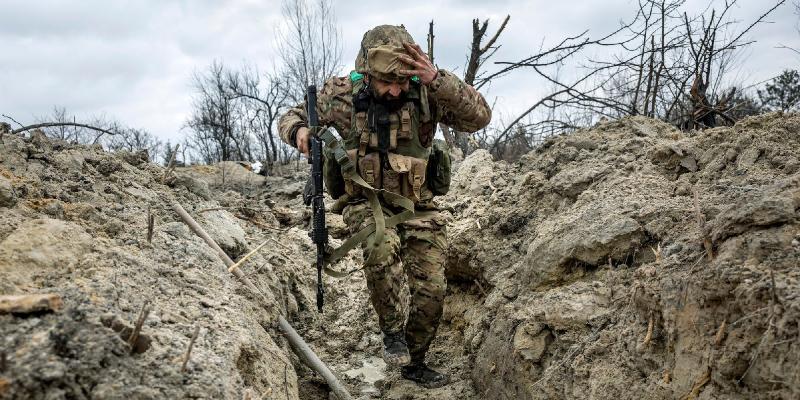US Warned 'Golden Hour' to Save Soldiers May Not Exist Vs Russia. Ukraine Has Lost It.
By: Sinead Baker, Ryan Pickrell (Business Insider)


Vivek Ramaswamy only made his money with a mediocre medical scam. If Ramaswamy was smart, he would've invested in military drone manufacturing and for-profit medicine so he could rake it in on both ends of the pipeline. Just think about the aftermarket prosthetic market.

American generals predicted years ago that the intensity of future wars could upend lifesaving evacuations and medical care for injured troops.
That prediction is now a reality in Ukraine, where soldiers often can't get proper medical care within the "golden hour" — the critical first 60 minutes after severe injuries when treatment can increase chances of survival.
"Until there's a real concrete answer for drones, it's going to continue to be pretty hectic when it comes to that type of care," a combat medic with a foreign volunteer unit in Ukraine told Business Insider.
The medic, who uses the call sign Tango, has front-line experience with Chosen Company, including an ill-fated fight in the village of Pervomaiske where his team was devastated by Russian indirect fire in July 2023. Despite his own injuries, he helped provide first aid to a handful of wounded men, but they had to wait hours for more extensive care. Two men didn't survive.
In Ukraine, swarms of drones and constant artillery strikes complicate timely evacuations, contributing to the war's soaring death toll and the severity of survivors' injuries.
Ukrainian soldiers taking part in medical training on the front line in Ukraine's Donetsk Oblast. Ignacio Marin/Anadolu via Getty Images
Asked in 2019 by Congress whether the US military would be able to evacuate wounded troops during the golden hour in future conflicts, Gen. Mark Milley, then the Army's chief of staff and later the chairman of the Joint Chiefs of Staff, gave a grim response.
"Probably not," he said.
"We'll try," he added, "but I'm not guaranteeing."
Other military leaders have expressed similar concerns. "You may have previously heard a discussion of the 'golden hour,'" Maj. Gen. Anthony McQueen, now the Army's deputy surgeon general but formerly the head of its Medical Research and Development Command, said last year. "We're moving more to a 'golden window of opportunity.'"
On any given day in Ukraine, wounded soldiers may be stuck near the front lines for hours or days and can be evacuated only during a break in the fighting or in the dim light of dawn and dusk.
"Here in Ukraine," a US Army veteran fighting in Ukraine who goes by the call sign Jackie told BI, "we have a golden three days."
A struggle to evacuate
A Ukrainian combat medic who requested anonymity due to the sensitivity of the work she does told BI the struggle to quickly evacuate was "a big problem" that had only worsened with drones becoming more prolific. "Two years ago," she said, "it was a totally different war from what is going on now."
The Ukrainian military operating a Punisher drone. Libkos via Getty Images
An estimated 1 million people have been killed or injured in the Ukraine war, with casualties stemming heavily from drones and artillery.
Cheap drones swarming the skies over Ukraine's battlefields can severely delay medical evacuations. The drones serve as aerial eyes for artillery, bombers that can drop grenades, and precision-strike munitions.
The Ukrainian medic said Russian troops target vehicles known to be carrying out evacuations, a war crime about which other Ukrainian troops have repeatedly raised concerns in this war. Russia did not immediately respond to BI's request for comment on the allegations.
They aim for the combat medics, she said, because "if you kill a medic, it means that you killed thousands of soldiers," or all the people they might have saved otherwise.
"If you look special or different, you are going to attract a drone," Tango said. "That goes especially for evac, and they specifically target medical vehicles or anybody with a backpack. You never wear a medic patch on the front line. That's a guaranteed drone strike."
Drones are only one of the war's many causes of bodily harm and death. A 2023 medical study found that 70% of Ukrainian war injuries were caused by shelling or rocket fire.
Graves at the Lychakiv cemetery in Lviv, Ukraine, of Ukrainian soldiers killed since Russia launched its full-scale invasion. AP Photo/Mykola Tys
The Ukrainian medic said first responders sometimes reach injured soldiers quickly but can't evacuate if nearby roads are controlled by Russians or exposed to drones.
That can mean waiting hours or even days.
Extended delays in crucial care could lead to complications, such as amputations, or even fatalities that faster clinical care might have avoided. Leaving a tourniquet on too long, for example, can cause lasting nerve damage.
Jackie said a friend of his was wounded by shrapnel but couldn't leave his trench near the eastern city of Bakhmut for four days. His wounded leg became infected and ultimately had to be cut off.
Jackie thought the injury would have been an "easy fix" if the friend had received care in the golden hour. "We don't have a field medic up there pushing antibiotics through IVs, right under direct fire in a trench," he said.
Separately, a Ukrainian drone operator said that when he and his fellow soldiers were attacked by drones, one of his friends had to wait 12 hours before he could get proper medical treatment. One of the friend's legs later had to be amputated.
Drones give rise to 'magic hour' evacuations
In the cult-classic sci-fi film "Reign of Fire," "magic hour" occurs at dusk and dawn; it's the time of day when the dragons, deadly airborne dangers, are vulnerable. Tango said medics operating in Ukraine could find a similar respite at those times.
"That's when they're switching out their surveillance drones from normal analog video to either thermal or night vision," he said. "You have that limited window to move people."
Tango said, "You can't move during the daytime, or you'll get wrecked by drones." And the night has its own drone terrors.
Fighting typically slows at dawn and dusk as soldiers rest and swap equipment, though the Russians sometimes use artillery to suppress the Ukrainians during this period. A soldier hit outside this time typically must wait hours for an evacuation.
Once they can be moved, injured soldiers are typically taken back to a casualty collection point, like an underground bunker or concealed position, to be stabilized until it is safe for a truck or armored vehicle to take them to a field hospital.
What it means for the West
Drones have been used more in the war in Ukraine than in any other conflict in history, limiting battlefield movement. And the proliferation of sophisticated air defenses has prevented either side — Ukraine or Russia — from achieving air supremacy or even superiority. That makes it too risky for helicopters to rapidly pick up the wounded, as was standard in the US wars in Iraq and Afghanistan.
Recalling his Iraq deployment a decade ago, Tango said, "I knew even if I got really messed up, there is a pretty good chance I'm going to survive." He said that he "could get wrecked and probably be at a hospital within an hour or two."
In Ukraine, he said, "it's a gamble every time you step off on a mission."
The US could face similar obstacles in the event of a large-scale conflict against an adversary like China or Russia.
US Army Col. Matthew Fandre, then the senior medical officer for the Mission Command Training Program, wrote in 2020 that in a future large-scale war involving the US, the "golden hour will become a goal, not an expectation."
"This is not a paradigm shift; instead, it would be a return to the patterns and expectations of World War II operations and Cold War planning, exacerbated by current technology and lethality," Fandre wrote.
He said that without air superiority, aerial evacuations could become limited, leaving ground evacuations as the primary method. But ground evacuations would most likely also have limits, he wrote, which could "dramatically increase died-of-wounds rates."
George Barros, a conflict analyst at the US-based Institute for the Study of War, told BI that America and its allies needed a "tremendous amount of learning" to help "prepare to deter and, if necessary, defeat modern state peer adversaries like China and Russia." But there are also lessons from US experiences for Ukraine.
The US special-operations community has experience in prolonged battlefield combat care, something medics like Tango are increasingly studying and applying in Ukraine. Expanding that to the military on a large scale could be challenging, though. Troops are also considering drone deliveries of supplies into contested battlespaces, but that capability is still in the early stages.
Until then, many soldiers will continue to fight the clock after injuries, hoping for breaks in the fighting that make lifesaving treatments more accessible.







A 155mm artillery shell typically costs between $3,000 and $5,000 apiece. The US kamikaze drones can be produced for less than $1,000 apiece with on-board targeting capability. The lighter and less bulky drones also reduce the logistical challenges since they can be delivered in backpacks carried by canon fodder.
BTW, this sort of warfare really began during WWI with observation balloons spotting for machine gun placements, artillery, and aircraft. The new technology has only increased the efficiency and lowered the cost. It's unclear if the new technology has really improved profitability of arms manufacturing.